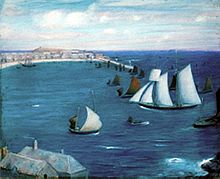St Ives (Cornwall)
| St Ives | |||
|---|---|---|---|
|
 Location in the former District of Penwith Location in the former District of Penwith
|
||
| Basic data | |||
| status |
Civil Parish (1974) |
||
| region | South West England | ||
| Ceremony county | Cornwall | ||
| Trad. county | Cornwall | ||
| Administrative headquarters | St Ives | ||
| Residents | approx.11,000 (2012) | ||
| Post Code | TR26 2xx | ||
| Telephone code | 01736 | ||
| Sub-locations | Lelant , Carbis Bay , Halsetown, St Ives | ||
| Website | www.stives-cornwall.co.uk | ||
St Ives ( Cornish Porth Ia [KK], Porth Ya [UCR] ) is a town in the county of Cornwall in England and has a population of about 11,000. The name is derived from the Cornish saint Ia , after whom the local church, St Ia's Church , is named. St Ives is known as a popular holiday resort and artist colony .
Tourist importance
In 1877 a railway line was built from the nearby parish of St Erth to St Ives. The city then became a popular excursion and holiday destination, not least because the town itself has two large beaches (Porthminster Beach and Porthmeor Beach) and another small beach (Porthgwidden Beach).
Carbis Bay and the miles-long beach of St Ives Bay are close by. All beaches have already received several awards for their location, their views and their fine white sand.
Artistic importance
The Scottish painter Thomas Millie Dow (1848-1919) moved to St Ives in 1894 and lived there until his death. In 1895 he acquired Talland House from Leslie Stephen , father of Virginia Woolf .
Bernard Leach (1887–1979) and the Japanese Shoji Hamada (1894–1978) founded the Leach Pottery in St Ives in 1920. They made pottery from the point of view of Western and Eastern art and philosophy. Leach worked until 1972; five years later, in 1977, the Victoria and Albert Museum in London showed his work. The Leach Pottery is still operating and has a small museum showing Leach's works and those of his students.
Ben Nicholson , Alfred Wallis and Christopher Wood founded an artist colony in the city in 1928. In 1993 the London Tate Gallery opened an offshoot in St Ives on Porthmeor Beach with the works of the artists who worked there, such as Ben Nicholson and his wife Barbara Hepworth , one of the most famous English sculptors, whose works are also in their own, idyllically located museum, her previous one (Trewyn-) Studio.
An important modern painter has also lived in St Ives since 1974: Roy Ray (* 1936), who gives expression to the Cornish language and landscape with his pictures. In 1913 the composer George Lloyd was born in St Ives.
The British writer Virginia Woolf spent the summer months in St Ives with her family from 1882 to 1894 as a child. Woolf, who had a very unhappy youth, later dedicated the novel to Jacob's Room to St Ives and Cornwall . Her novel The Journey to the Lighthouse is - although it is set on the Hebridean island of Skye - a reminiscence of St Ives. The former summer home of Woolf's father Leslie Stephen , Talland House , is near Porthminster Beach. It was owned by the Stephen family from 1882 to 1895.
St Ives is also home to a number of novels such as Die Musselsucher by Rosamunde Pilcher , who is also popular in Germany and whose birthplace Lelant is not far away. St Ives is called Porthkerris in her books and often served as the backdrop for the novel adaptations that are also known in Germany.
Picture gallery
Photochrom from St Ives, 1895
sons and daughters of the town
- Peter Lanyon (1918–1964), painter
- George Lloyd (1913–1998), composer
- Robert Whitaker McAll (1821-1893), congretionalist preacher
literature
- Julia Kaufhold: St Ives and trips to the area . goldfinch Verlag, Hamburg 2007, ISBN 978-3-940258-00-7
Web links
- St Ives Town Council (English)
- Website of the Tate St Ives (English)
Individual evidence
- ↑ Thomas Millie Dow , cornwallartists.org
- ^ Bernard Leach ( Memento of May 28, 2013 in the Internet Archive ), leachpottery.com
- ↑ Leach Pottery , leachpottery.com
- ↑ Roy Ray , stisa.co.uk
Coordinates: 50 ° 13 ′ N , 5 ° 29 ′ W



















